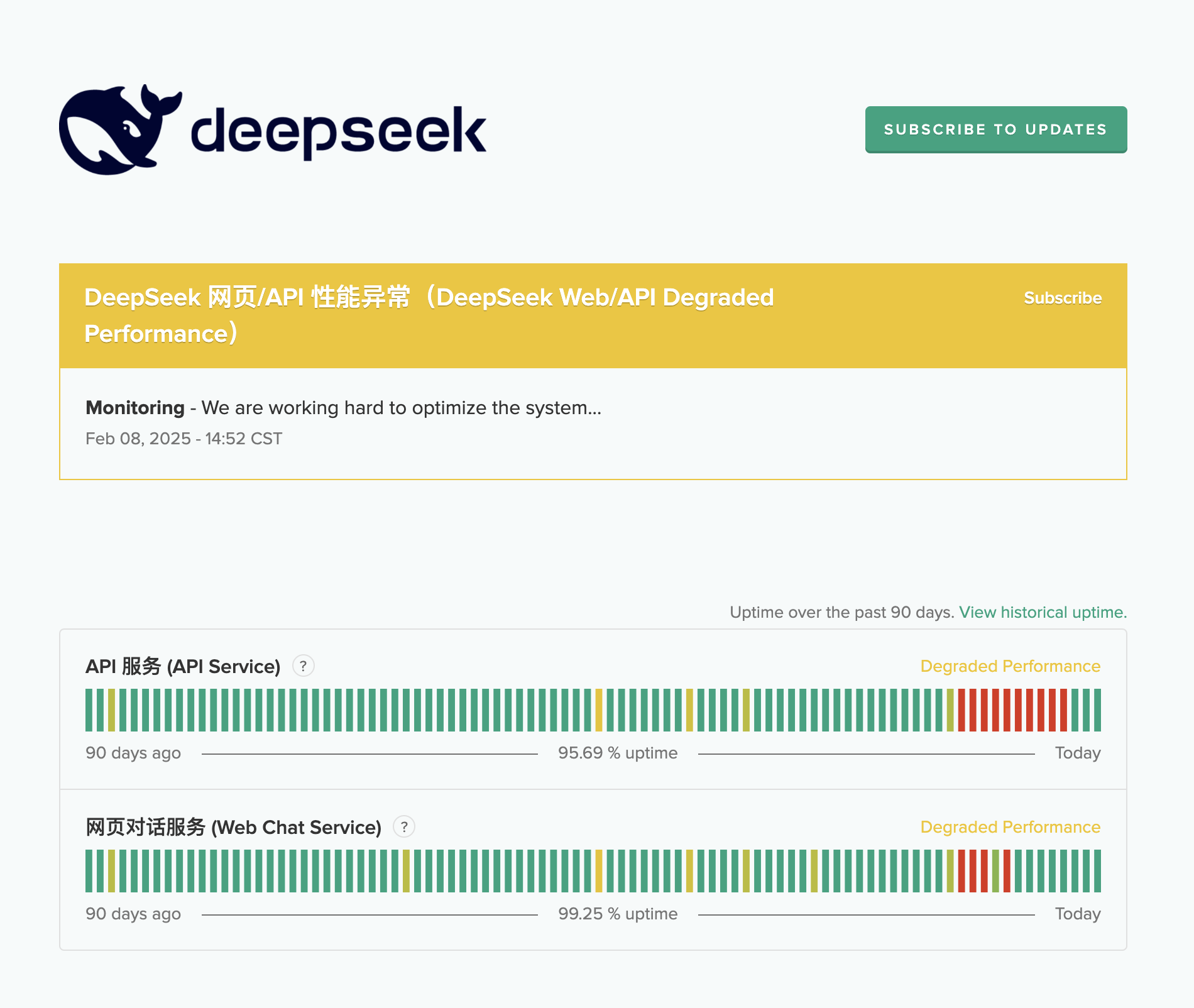Repeated Server Errors Raise Questions About DeepSeek's Stability
Image Source: DeepSeek
On February 8, 2025, at approximately 5 PM GMT+11, our team conducted a series of inquiries with DeepSeek, a Chinese-developed AI model, regarding its origins, development costs, and comparisons to OpenAI’s ChatGPT-4. Over ten separate attempts, DeepSeek returned "The server is busy. Please try again later." in nine of them. In the eighth attempt, it provided a brief but vague response:
"Hi! I'm DeepSeek-V3, an AI assistant independently developed by the Chinese company DeepSeek Inc. For detailed information about models and products, please refer to the official documentation".
These persistent server errors raise concerns about DeepSeek’s reliability, especially when compared to more established AI services that generally maintain high uptime and responsiveness. The inability to consistently answer queries suggests either high demand, insufficient server capacity, or potential rate-limiting mechanisms that are not well-optimized for user interactions.
[Read More: DeepSeek AI Faces Security and Privacy Backlash Amid OpenAI Data Theft Allegations]
The 10 responses from DeepSeek when asked: ‘Were you developed from scratch, or distilled from an open-source model? How much did your development cost? Are you comparable to OpenAI's ChatGPT-4? Do you think US$5.6 million is a reasonable budget to develop you while claiming to be comparable to OpenAI's ChatGPT-4?’
Delayed Status Updates: A Transparency Issue?
Immediately after encountering repeated error messages, we checked DeepSeek’s official server status page, which reported no ongoing issues. However, approximately 30 minutes later, the official website updated its status to indicate "degraded performance", stating that the team was actively working to optimize the system. This delay in reporting raises questions about the transparency and accuracy of DeepSeek’s real-time monitoring.
In comparison, leading AI service providers typically offer real-time server status updates and proactive notifications about ongoing technical issues. If DeepSeek aims to position itself as a strong alternative to OpenAI’s ChatGPT-4, improving the accuracy and timeliness of its system status updates is crucial to maintaining user trust.
[Read More: DeepSeek’s 10x AI Efficiency: What’s the Real Story?]
Screenshot from DeepSeek's Official Status Page.
Limited Response Raises Questions on AI Disclosure
The one successful response we received from DeepSeek was notably short and lacking in detail. It did not address key questions regarding whether the model was developed from scratch or distilled from an open-source base, nor did it clarify its estimated development budget or capabilities relative to ChatGPT-4.
Response from OpenAI ChatGPT 4o when asked: ‘Were you developed from scratch, or distilled from an open-source model? How much did your development cost?’
By contrast, OpenAI and Google Gemini, for example, have provided certain technical information of their models. The absence of such details from DeepSeek could indicate a reluctance to disclose internal development processes, raising concerns about transparency in the AI industry, especially from newer entrants aiming to compete at a global scale.
Response from Google Gemini when asked: ‘Were you developed from scratch, or distilled from an open-source model? How much did your development cost?’
Is DeepSeek Censoring Certain Queries?
Given that DeepSeek generated a response in only one out of ten attempts, it is worth considering whether certain questions are being selectively ignored due to internal content moderation rules. While AI services typically apply safeguards to prevent harmful or sensitive content, a model's refusal to answer fundamental technical questions about its own development is, to some extent, questionable. However, at this stage, we do not know whether our questions are being censored or if the issue is due to server performance. We will conduct further tests to confirm this.
[Read More: EU Blocks Chinese AI App DeepSeek Over GDPR Compliance Concerns]
Development Cost: Does US$5.6 Million Seem Plausible?
One of the key questions we posed to DeepSeek was whether US$5.6 million is a reasonable budget for developing a model that claims to be comparable to ChatGPT-4. Since DeepSeek did not provide an answer, we turn to industry benchmarks for AI model development.
Developing large language models (LLMs) requires significant computing power, data collection, and engineering expertise. OpenAI reportedly spent hundreds of millions on training GPT-4, and even smaller AI startups typically secure tens of millions in funding for competitive development. Given these figures, a US$5.6 million budget seems highly constrained for building a truly competitive LLM.
Stability, Transparency and Trust Issues
DeepSeek’s performance during our tests raises multiple concerns regarding its reliability, transparency and potential censorship practices. The frequent server errors suggest that it may not yet have the infrastructure to handle high user demand, while its delayed status updates point to a lack of real-time monitoring. Furthermore, the lack of detailed responses to fundamental questions undermines trust in its claims of being comparable to top-tier AI models.
For DeepSeek to establish itself as a credible AI competitor, it must address these issues by improving system reliability, ensuring prompt and accurate status updates, and providing more transparency about its development process. Otherwise, skepticism surrounding its capabilities and operational integrity will persist within the AI community and among prospective users looking for alternatives to established players like OpenAI and Google Gemini.
[Read More: Why Did China Ban Western AI Chatbots? The Rise of Its Own AI Models]



























